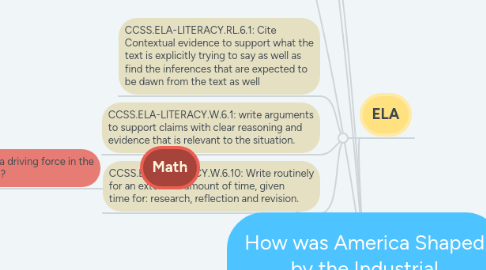
1. CCSS.ELA-LITERACY.RL.6.3: Describe a story's plot as it unfolds as well as how the characters respond the unfolding plotline as it moves towards its resolution point
2. CCSS.ELA-LITERACY.RL.6.3: Describe a story's plot as it unfolds as well as how the characters respond the unfolding plotline as it moves towards its resolution point
3. CCSS.ELA-LITERACY.W.6.A: Introduce claims and organize the reasoning and evidence clearly
4. ELA
4.1. CCSS.ELA-LITERACY.RL.6.1: Cite Contextual evidence to support what the text is explicitly trying to say as well as find the inferences that are expected to be dawn from the text as well
4.2. CCSS.ELA-LITERACY.W.6.1: write arguments to support claims with clear reasoning and evidence that is relevant to the situation.
4.3. CCSS.ELA-LITERACY.W.6.10: Write routinely for an extended amount of time, given time for: research, reflection and revision.
5. Math
5.1. How was efficincey a driving force in the Industrial Revolution?
5.1.1. CCSS.MATH.CONTENT.6.RP.A.3: Use ratio and rate reasoning to solve real world issues and other mathematical problems with multiple methods
5.1.1.1. CCSS.MATH.CONTENT.6.RP.A.3.a: Make tables to show ratios with whole measurments, find missing values and plot values in a coordinate plane
5.1.1.2. CCSS.MATH.CONTENT.6.RP.A.3.b: Solve unit rate problems including pricing and constant speed
5.1.1.3. CCSS.MATH.CONTENT.6.RP.A.3.c: Find percent of quantity A rate per 100
5.1.1.4. CCSS.MATH.CONTENT.6.RP.A.3.d: Use ratio reasoning to convert measurement units; manipulate and transform units appropriately
5.1.2. CCSS.MATH.CONTENT.6.SP.A.2: Understand a set of data collected in order to answer a statistical question that has distrubutional data that can be described as cented, spread or overall shape
5.1.3. CCSS.MATH.CONTENT.6.SP.B.4: Display numerical data in plots on a number line, including dot plots, histograms and box plots.
5.1.4. CCSS.MATH.CONTENT.6.SP.B.5: Summarize the date found in sets of numerical data in relation to the context in which it is presented
6. Social Science
6.1. How did the American Industrial Revolution come about? What were the effects?
6.1.1. SS.IS.4.6-8: Looking at multiple points of view when organizing a research plan
6.1.1.1. SS.IS.4.6-8.LC: Evaluating Resources
6.1.2. SS.IS.5.6-8.LC: Appropriately Cite Sources
6.1.3. SS.IS.8.6-8.LC: Adress a aproblem and the challenges and opportunities faced by those who try to fix the problem
6.1.4. SS.CV.1.6-8.LC: Know the roles that citizens play within a society and/or community
6.1.5. SS.CV.2.6-8.LC: Describe the origins, purposes, and impact of different forms of laws, treaties and international agreements
7. Science
7.1. MS-ESS3: EARTH AND HUMAN ACTIVITY:
7.1.1. MS-ESS3-2: EARTH AND HUMAN ACTIVITY: Students will be able to analyze and interpret data of natural hazards to forecast future events and inform the future development of technologies to help mitigate their effect
7.1.2. MS-ESS3-3:EARTH AND HUMAN ACTIVITY: Students will apply scientific principles to design a method for monitoring human impact on the enviornment
7.1.3. MS-ESS3-4: EARTH AND HUMAN ACTIVITY: Students will construct and argument that is supported by evidence about the increase of human population in relation to the impact of the consumption of Earth's natural resources
7.2. MS-ETS1-ENGINEERING DESIGN:
7.2.1. MS-ETS1-2: ENGINEERING DESIGN: Students wll evaluate competing design solutions with a specific proces that helps determine how well they meet criteria of the problem at hand
7.2.2. MS-EST1-3: ENGENEERING DESIGN: Analyze Date from tests to determine similarities and differences among several designs to identify the best characteristics to create a new solution for better success

